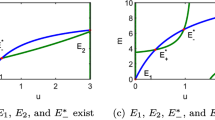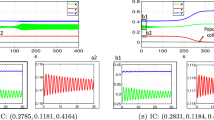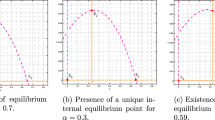Abstract
A two-species predator–prey model where the predators are separated into juvenile and mature predators has been considered in this article. Here, functional response in linear form is considered to know the impact of adult predator-induced fear in the stage-structured prey–predator model. Positivity and boundedness of the model system have been checked. Persistence conditions and existence condition(s) of each equilibria have been derived. The local and global stability analysis have been implemented both analytically and numerically along with Hopf bifurcation analysis with direction. From the analysis of the model system, it is observed that the mature predator-induced fear and rate of transition from juvenile (minor) predator to mature predator plays a crucial role in controlling the system dynamics.











Similar content being viewed by others
References
Aiello, W. G., & Freedman, H. (1990). A time-delay model of single-species growth with stage structure. Mathematical biosciences, 101(2), 139–153.
Aljetlawi, A. A., Sparrevik, E., & Leonardsson, K. (2004). Prey−predator size-dependent functional response: derivation and rescaling to the real world. Journal of Animal Ecology, 73(2), 239–252.
Bandyopadhyay, M., & Banerjee, S. (2006). A stage-structured prey−predator model with discrete time delay. Applied Mathematics and Computation, 182(2), 1385–1398.
Barman, D., Roy, J., & Alam, S. (2020). Trade-off between fear level induced by predator and infection rate among prey species. Journal of Applied Mathematics and Computing, 64, 635–663. https://doi.org/10.1007/s12190-020-01372-1.
Chattopadhyay, J., Sarkar, R. R., & El Abdllaoui, A. (2002). A delay differential equation model on harmful algal blooms in the presence of toxic substances. Mathematical Medicine and Biology: A Journal of the IMA, 19(2), 137–161.
Creel, S., & Christianson, D. (2008). Relationships between direct predation and risk effects. Trends in Ecology & Evolution, 23(4), 194–201.
Creel, S., Christianson, D., Liley, S., & Winnie, J. A. (2007). Predation risk affects reproductive physiology and demography of elk. Science, 315(5814), 960–960.
Cresswell, W. (2011). Predation in bird populations. Journal of Ornithology, 152(1), 251–263.
Das, A., & Samanta, G. (2018). Modeling the fear effect on a stochastic prey−predator system with additional food for the predator. Journal of Physics A: Mathematical and Theoretical, 51(46), 465601.
Dhooge, A., Govaerts, W., & Kuznetsov, Y. A. (2003). Matcont: a matlab package for numerical bifurcation analysis of odes. ACM Transactions on Mathematical Software (TOMS), 29(2), 141–164.
Elliott, K. H., Betini, G. S., & Norris, D. R. (2017). Fear creates an allee effect: experimental evidence from seasonal populations. Proceedings of the Royal Society B: Biological Sciences, 284(1857), 20170878.
Freedman, H., & Ruan, S. G. (1995). Uniform persistence in functional differential equations. Journal of Differential Equations, 115(1), 173–192.
Gakkhar, S., & Gupta, K. (2017). Dynamics of a stage-structured predator–prey model. International Journal of Applied Physics and Mathematics, 7(1), 24.
Georgescu, P., & Hsieh, Y. H. (2007). Global dynamics of a predator–prey model with stage structure for the predator. SIAM Journal on Applied Mathematics, 67(5), 1379–1395.
Georgescu, P., & Morosanu, G. (2006). Global stability for a stage-structured predator–prey model. Mathematical Sciences Research Journal, 10(8), 214.
Gourley, S. A., & Kuang, Y. (2004). A stage structured predator–prey model and its dependence on maturation delay and death rate. Journal of Mathematical Biology, 49(2), 188–200.
Hassard, B.D., Hassard, B., Kazarinoff, N.D., Wan, Y.H., & Wan, Y.W. (1981). Theory and applications of Hopf bifurcation (vol 41). CUP Archive
Hespenheide, H. A. (1973). Ecological inferences from morphological data. Annual Review of Ecology and Systematics, 4(1), 213–229.
Huang, C., Qiao, Y., & Huang, L. (2018). Agarwal RP (2018) Dynamical behaviors of a food-chain model with stage structure and time delays. Advances in Difference Equations, 1, 186.
John Power, R., & Shem Compion, R. (2009). Lion predation on elephants in the savuti, chobe national park, botswana. African Zoology, 44(1), 36–44.
Kar, T., & Matsuda, H. (2006). Controllability of a harvested prey−predator system with time delay. Journal of Biological Systems, 14(02), 243–254.
Khajanchi, S. (2014). Dynamic behavior of a beddington-deangelis type stage structured predator–prey model. Applied Mathematics and Computation, 244, 344–360.
Khajanchi, S. (2017). Modeling the dynamics of stage-structure predator–prey system with monod-haldane type response function. Applied Mathematics and Computation, 302, 122–143.
Kundu, S., & Maitra, S. (2018). Dynamics of a delayed predator–prey system with stage structure and cooperation for preys. Chaos, Solitons & Fractals, 114, 453–460.
LaSalle, J. P. (1976). The stability of dynamical systems (Vol. 25). Philadelphia: SIAM.
Lima, S. L. (1998). Nonlethal effects in the ecology of predator–prey interactions. Bioscience, 48(1), 25–34.
Lima, S. L. (2009). Predators and the breeding bird: behavioral and reproductive flexibility under the risk of predation. Biological Reviews, 84(3), 485–513.
Lingle, S. (2001). Anti-predator strategies and grouping patterns in white-tailed deer and mule deer. Ethology, 107(4), 295–314.
Lu, Y., Pawelek, K. A., & Liu, S. (2017). A stage-structured predator–prey model with predation over juvenile prey. Applied Mathematics and Computation, 297, 115–130.
Magnússon, K. G. (1999). Destabilizing effect of cannibalism on a structured predator–prey system. Mathematical Biosciences, 155(1), 61–75.
Meng, X. Y., Huo, H. F., Xiang, H., & Qy, Yin. (2014). Stability in a predator–prey model with crowley-martin function and stage structure for prey. Applied Mathematics and Computation, 232, 810–819.
Nagumo, M. (1942). Über die lage der integralkurven gewöhnlicher differentialgleichungen. In Proceedings of the physico-mathematical society of Japan 3rd series (Vol. 24, pp. 551–559)
Pal, S., Majhi, S., Mandal, S., & Pal, N. (2019a). Role of fear in a predator–prey model with beddington-deangelis functional response. Zeitschrift für Naturforschung A, 74(7), 581–595.
Pal, S., Pal, N., Samanta, S., & Chattopadhyay, J. (2019b). Effect of hunting cooperation and fear in a predator–prey model. Ecological Complexity, 39, 100770.
Panday, P., Pal, N., Samanta, S., & Chattopadhyay, J. (2018). Stability and bifurcation analysis of a three-species food chain model with fear. International Journal of Bifurcation and Chaos, 28(01), 1850009.
Panday, P., Pal, N., Samanta, S., & Chattopadhyay, J. (2019). A three species food chain model with fear induced trophic cascade. International Journal of Applied and Computational Mathematics, 5(4), 100.
Panja, P., Mondal, S. K., & Chattopadhyay, J. (2017). Dynamical effects of anti-predator behaviour of adult prey in a predator–prey model with ratio-dependent functional response. Asian Journal of Mathematics and Physics, 1, 19–32.
Peacor, S. D., Peckarsky, B. L., Trussell, G. C., & Vonesh, J. R. (2013). Costs of predator-induced phenotypic plasticity: a graphical model for predicting the contribution of nonconsumptive and consumptive effects of predators on prey. Oecologia, 171(1), 1–10.
Pettorelli, N., Coulson, T., Durant, S. M., & Gaillard, J. M. (2011). Predation, individual variability and vertebrate population dynamics. Oecologia, 167(2), 305.
Preisser, E. L., & Bolnick, D. I. (2008). The many faces of fear: comparing the pathways and impacts of nonconsumptive predator effects on prey populations. PloS ONE, 3(6), e2465.
Roy, J., & Alam, S. (2019a). Dynamics of an autonomous food chain model and existence of global attractor of the associated non-autonomous system. International Journal of Biomathematics, 12, 1950082.
Roy, J., & Alam, S. (2019b). Fear factor in a prey−predator system in deterministic and stochastic environment. Physica A: Statistical Mechanics and its Applications, 541, 123359.
Roy, J., Barman, D., & Alam, S. (2020). Role of fear in a predator–prey system with ratio-dependent functional response in deterministic and stochastic environment. Biosystems, 197, 104176.
Saitō, Y. (1986). Prey kills predator: counter-attack success of a spider mite against its specific phytoseiid predator. Experimental & Applied Acarology, 2(1), 47–62.
Sasmal, S. K. (2018). Population dynamics with multiple allee effects induced by fear factors-a mathematical study on prey−predator interactions. Applied Mathematical Modelling, 64, 1–14.
Svennungsen, T. O., Holen, Ø. H., & Leimar, O. (2011). Inducible defenses: continuous reaction norms or threshold traits? The American Naturalist, 178(3), 397–410.
Wang, W., & Chen, L. (1997). A predator–prey system with stage-structure for predator. Computers & Mathematics with Applications, 33(8), 83–91.
Wang, X., & Zou, X. (2017). Modeling the fear effect in predator–prey interactions with adaptive avoidance of predators. Bulletin of Mathematical Biology, 79(6), 1325–1359.
Wang, X., Zanette, L., & Zou, X. (2016). Modelling the fear effect in predator–prey interactions. Journal of Mathematical Biology, 73(5), 1179–1204.
Xiao, Y. N., & Chen, L. S. (2004). Global stability of a predator–prey system with stage structure for the predator. Acta Mathematica Sinica, 20(1), 63–70.
Zanette, L. Y., White, A. F., Allen, M. C., & Clinchy, M. (2011). Perceived predation risk reduces the number of offspring songbirds produce per year. Science, 334(6061), 1398–1401.
Acknowledgements
Mr. Barman is thankful to Ministry of Human Resource Development (MHRD), India, for financial support for this research study.
Author information
Authors and Affiliations
Corresponding author
Additional information
Publisher's Note
Springer Nature remains neutral with regard to jurisdictional claims in published maps and institutional affiliations.
Rights and permissions
About this article
Cite this article
Mondal, N., Barman, D. & Alam, S. Impact of adult predator incited fear in a stage-structured prey–predator model. Environ Dev Sustain 23, 9280–9307 (2021). https://doi.org/10.1007/s10668-020-01024-1
Received:
Accepted:
Published:
Issue Date:
DOI: https://doi.org/10.1007/s10668-020-01024-1




